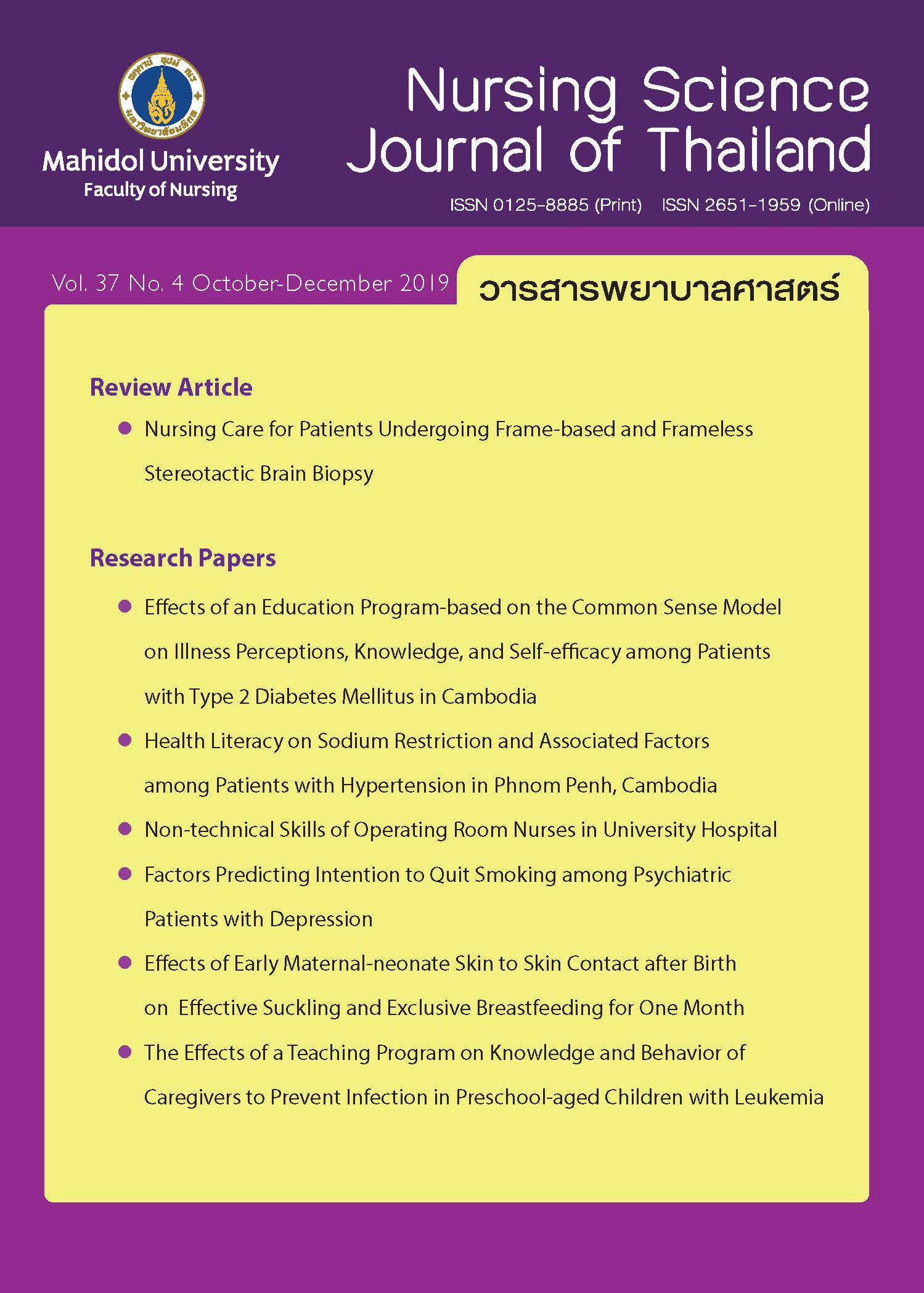ปัจจัยทำนายความตั้งใจในการเลิกสูบบุหรี่ของผู้ป่วยจิตเวชที่มีภาวะซึมเศร้า
Main Article Content
บทคัดย่อ
วัตถุประสงค์: การศึกษาครั้งนี้มีวัตถุประสงค์เพื่อศึกษาปัจจัยทำนายความตั้งใจในการเลิกสูบบุหรี่ของผู้ป่วยจิตเวชที่มีภาวะซึมเศร้า
รูปแบบการวิจัย: การศึกษาความสัมพันธ์เชิงทำนาย
วิธีดำเนินการวิจัย: กลุ่มตัวอย่างคือ ผู้ป่วยจิตเวชที่มีภาวะซึมเศร้าและยังคงมีพฤติกรรมสูบบุหรี่ ที่มารับบริการในคลินิกผู้ป่วยนอกของโรงพยาบาลจิตเวชและคลินิกสุขภาพจิตของโรงพยาบาลในภาคใต้ จำนวน 132 คน เลือกกลุ่มตัวอย่างแบบเฉพาะเจาะจง เครื่องมือที่ใช้ในการวิจัยประกอบด้วย 7 ส่วน คือ 1) แบบสอบ ถามข้อมูลทั่วไป 2) แบบสอบถามข้อมูลการใช้บุหรี่ 3) แบบสอบถามฟาเกอร์สตรอมเพื่อวัดระดับการติดนิโคติน 4) แบบสอบถามความตั้งใจในการเลิกสูบบุหรี่ของผู้ป่วยจิตเวชที่มีภาวะซึมเศร้า 5) แบบสอบถามเจตคติต่อการเลิกสูบบุหรี่ของผู้ป่วยจิตเวชที่มีภาวะซึมเศร้า 6) แบบสอบถามการคล้อยตามกลุ่มอ้างอิงในการเลิกสูบบุหรี่ของผู้ป่วยจิตเวชที่มีภาวะซึมเศร้า และ 7) แบบสอบถามการรับรู้ความสามารถในการควบคุมพฤติกรรมเลิกสูบบุหรี่ของผู้ป่วยจิตเวชที่มีภาวะซึมเศร้า วิเคราะห์ข้อมูลโดยใช้สถิติพรรณา และวิเคราะห์ปัจจัยทำนายโดยใช้สถิติถดถอยพหุคูณแบบขั้นตอน
ผลการวิจัย: การรับรู้ความสามารถในการควบคุมพฤติกรรมเลิกสูบบุหรี่และระดับการเสพติดสารนิโคตินสามารถร่วมกันทำนายได้ร้อยละ 11 (R2 = .110, p = .010) โดยตัวแปรที่สามารถทำนายความตั้งใจในการเลิกสูบบุหรี่ของผู้ป่วยจิตเวชที่มีภาวะซึมเศร้าได้อย่างมีนัยสำคัญทางสถิติ คือ การรับรู้ความสามารถในการเลิกสูบบุหรี่ (β = .283, t = 3.411, p = .001) และระดับการเสพติดสารนิโคติน (β = - .193, t = 2.334, p = .021)
สรุปและข้อเสนอแนะ: จากผลการวิจัยที่พบว่า การรับรู้ความสามารถในการควบคุมพฤติกรรมเลิกสูบบุหรี่ และระดับการเสพติดสารนิโคตินสามารถร่วมทำนายความตั้งใจในการเลิกสูบบุหรี่อย่างมีนัยสำคัญทางสถิติ พยาบาลจึงควรพัฒนาแนวทางการประเมินพฤติกรรมการสูบบุหรี่ และเพิ่มความตั้งใจต่อการเลิกสูบบุหรี่ด้วยการสร้างเสริมการรับรู้ความสามารถในการควบคุมพฤติกรรมเลิกสูบบุหรี่ ร่วมกับให้ความสำคัญกับการใช้สารนิโคตินทดแทน เพื่อให้การเลิกสูบบุหรี่ของผู้ป่วยจิตเวชที่มีภาวะซึมเศร้าเกิดประสิทธิภาพยิ่งขึ้น
Article Details
ลิขสิทธิ์: วารสารพยาบาลศาสตร์เป็นเจ้าของลิขสิทธิ์ในการเผยแพร่ผลงานที่ตีพิมพ์ ห้ามผู้ใดนำบทความที่ได้รับการตีพิมพ์ในวารสารพยาบาลศาสตร์ไปเผยแพร่ในลักษณะต่างๆ ดังต่อไปนี้ การส่งบทความไปตีพิมพ์เผยแพร่ที่อื่น การนำบทความเผยแพร่ออนไลน์ การถ่ายเอกสารบทความเพื่อกิจกรรมที่ไม่ใช่การเรียนการสอน ยกเว้นเสียแต่ได้รับอนุญาตจากวารสารพยาบาลศาสตร์

Disclaimer: เนื้อหาบทความหรือข้อคิดเห็นใดๆ ในวารสารพยาบาลศาสตร์ ถือเป็นความรับผิดชอบของผู้เขียน กองบรรณาธิการไม่จำเป็นต้องเห็นด้วยและไม่มีส่วนรับผิดชอบแต่อย่างใด
เอกสารอ้างอิง
2. Darun P, Handee N, Daenkhet P. Depression in patients with schizophrenia attending mental health clinic at Porncharoen Hospital, Beungkan Province. Journal of Nakhon Ratchasima Rajanagrindra Psychiatric Hospital. 2012;12:70-8. (in Thai).
3. Fergusson DM, Goodwin RD, Horwood LJ. Major depression and cigarette smoking: result of a 21-year longitudinal study. Psychol Med. 2003;33(8):1357-67. doi: 10.1017/s0033291703008596.
4. Bakhshaie J, Zvolensky MJ, Goodwin RD. Cigarette smoking and the onset and persistence of depression among adults in the United States: 1994–2005. Compr Psychiatry. 2015;60:142-8. doi: 10.1016/j.comppsych.2014.10.012.
5. Rungrueanghiranya S, Khongsakon R. Toxicity & management of tobacco dependence. Bangkok: Sahaprachaphanich; 2009. 761 p. (in Thai).
6. Aekwarangkoon S. Psychiatric nursing and mental health: science and art to practice. 3rd ed. Nakhon Si Thammarat: Walailak University Book Center; 2016. 352 p. (in Thai).
7. Munafo MR, Araya R. Cigarette smoking and depression: a question of causation. Br J Psychiatry. 2010;196(6):425-6. doi: 10.1192/bjp.bp.109.074880.
8. Tombor I, Shahab L, Herbec A, Neale J, Michie S, West R. Smoker identity and its potential role in young adults’ smoking behavior: a meta-ethnography. Health Psychol. 2015;34(10):992-1003. doi: 10.1037/hea0000191.
9. Paha K, Prechawong S. Attitudes, subjective norms, perceive behavioral, and intention to quit smoking in police officers. Journal of The Police Nurse. 2014;6(1):157-69. (in Thai).
10. Tongnaung P, Preechawong S, Ua-Kit N. Attitudes, subjective norms, perceived behavioral control, intention, quit smoking, women service workers. Journal of Tobacco Control. 2007;1(2):2-13. (in Thai).
11. Matrakul M, Kalampakorn S, Powwattana A. Factors predicting intention to quit hand-rolled cigarettes smokers in Chiangrai province. Thai Journal of Nursing. 2012;61(1):10-20. (in Thai).
12. Bledsoe LK. Smoking cessation: an application of theory of planned behavior to understanding progress through stages of change. Addict Behav. 2006;31(7):1271-6. doi: 10.1016/j.addbeh.2005.08.012.
13. Burkhalter JE, Warren B, Shuk E, Primavera L, Ostroff JS. Intention to quit smoking among lesbian, gay, bisexual, and transgender smoker. Nicotine Tob Res. 2009;11(11):1312-20. doi: 10.1093/ntr/ntp140.
14. Bursey M, Craig D. Attitude, subjective norm, perceived behavioral control, and intention related to adult smoking cessation after coronary artery bypass graft surgery. Public Health Nurs. 2000;17(6):460-7.
15. Droomers M, Schrijvers CT, Mackenbach JP. Educational differences in the intention to stop smoking: explanations based on the theory of planned behaviour. Eur J Public Health. 2004;14(2):194-8. doi: 10.1093/eurpub/14.2.194.
16. Hoie M, Moan IS, Rise J. An extended version of the theory of planned behaviour: prediction of intention to quit smoking using past behavior as moderator. Addict Res Theory. 2010;18(5):572-85. doi:10.3109/16066350903474386.
17. Modeste N, Lee JW, Lim VJ, Anjejo D. Factors associated with intention to quit smoking among African American pregnant women. Calif J Health Promot. 2004;2(1):98-106. doi: 10.32398/cjhp.v2i1.587.
18. Ajzen I, Fishbein M. Understanding attitudes and predicting social behavior. Englewood Cliffs, NJ: Prentice-Hall; 1980. 278 p.
19. Ajzen I. Attitude, personality, and behavior. Chicago, IL: Dorsey Press; 1988. 175 p.
20. Islam K, Saha I, Saha R, Khan SA, Thakur R, Shivam S. Predictors of quitting behaviour with special reference to nicotine dependence among adult tobacco-users in a slum of Burdwan district, West Bengal, India. Indian J Med Res. 2014;139(4):638-42.
21. Ungcharoen R, Seeherunwong A, Kongsakon R, Sujirarat D. Beliefs and attitudes toward smoking cessation among vocational students with nicotine addiction and non-addiction. Journal of Nursing Science. 2014;32(4):52-77.
22. Srisathitnarakul B. Research methodology in nursing science. 5th ed. Bangkok: U & I Inter Media; 2010. 568 p. (in Thai).
23. Ramkhuan C, Khuwatsamrit K, Panpakdee O. Factors related to smoking cessation behavior among patients after coronary artery bypass graft. Thai Journal of Cardio-Thoracic Nursing. 2016;27(2):2-16. (in Thai).
24. Ajzen I. From intentions to actions: a theory of planned behavior. In: Kuhl J, Beckmann J, editors. Action control from cognition to behavior. Verlag Berlin Heidelberg: Springer; 1985. p.11-39.
25. Dixon L, Haas G, Weiden PJ, Sweeney J, Frances AJ. Drug abuse in schizophrenic patients: clinical correlates and reasons for use. Am J Psychiatry. 1991;148(2):224-30. doi: 10.1176/ajp.148.2.224.


